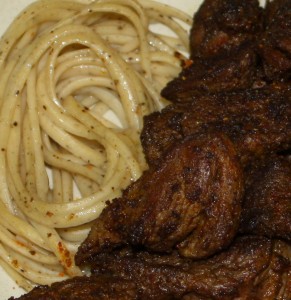Growing up and attending modern schools, I heard the story about how Marco Polo brought pasta to Europe from the Far East. In fact, pasta was already established in southern Europe by the time Marco Polo began his journey along the Silk Road.
What I later learned was that products similar to pasta existed during the 1st century AD (the Etrusco Roman era). Made from durum wheat and water, “lagane” was very similar to modern lasagna. However, instead of being boiled, it was cooked in an oven along with chickpeas and spices.
Conquered cultures have often adopted languages, foods, sciences, and arts from invading cultures. The Arab invasions of the 8th century were no exception and impacted much of the culinary cuisines along the Mediterranean Sea and this includes what we now know as pasta.
Modern pasta is usually served with a sauce that is tomato-, vegetable-, seafood-, meat- or cream-based. But that was not so in the early versions of pasta. The Arab version of pasta contained cinnamon, clove, dried fruit like figs and raisins and it tasted both semi-sweet and semi-spicy. As time went on, invaded cultures began changing this recipe to fit their own ideals and tastes. The exotic spices were removed as people began adding their own items to the dish – vegetables, calamari (squid), fish, pork, and chicken. Sauces were developed when cooking the aforementioned items in olive oil or butter, with wine and, once reduced (cooked-down), they were added to the pasta.
By the 12th century pasta was very popular; it could be dried and carried over long distances without spoiling. As people traveled, pasta was introduced to other cultures and those cultures began adapting the pasta to suit their needs.
It was the Italians who mastered the art of pasta making and made it their own culinary creation. Nowadays, different shapes of pasta have appeared and machines have made pasta easier to make. But there is something to be said about making your own pasta. The taste and texture is unique and modern dried pasta cannot match it.
The recipe below is an Arab version of pasta that I have been making over the years. When I first made this recipe during my travels, it was so different and delicious; I had to master making it on my own. I’ve performed this recipe at several demonstrations over the years and it continues to be a crowd favorite.
Ingredients:
2 cup flour
2 eggs
2 tbsp of olive oil
2 tbsp of water
1 tsp of salt
1 tsp of ground cinnamon
1/2 tsp of ground clove
1/2 tsp of ground nutmeg
honey
Blend ingredients together to form slightly rubbery dough. Knead on floured board and store for at least an hour in the fridge before using (a day is better).
If you can, use a pasta press to create spaghetti style pasta (normally this would be rolled out and hand cut). If you wish to roll it out, make sure that your table has enough flour upon it to avoid sticking. Roll the pasta so that it is about the thickness of an empty envelope and begin cutting the pasta by hand. Thick cuts will represent lasagna while thinner cuts will look like linguine or spaghetti.
Heat water with 2 tablespoons of salt to 2 tablespoons of oil in the water. Bring to a high boil and drop pasta in until el dente (between 2-3 minutes). Pull out of pot and let slightly cool out of bowl (clean cutting board works great).
Once slightly cool (warmer than room temp, but not hot) begin adding to a bowl mixing 1 teaspoon of honey to each layer and blend well without breaking the pasta.
I find this dish is served well with roast lamb or pork and makes an interesting side dish. In the photo, I’ve pair the pasta with a spicy, Middle Eastern flavored lamb.

I love pasta with mushrooms and walnuts!! Now I’ll know the more “civilized” recipe, with mascarpone cheese thank you!